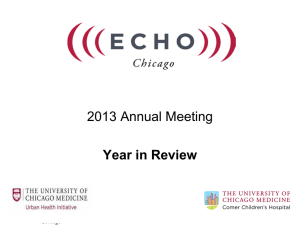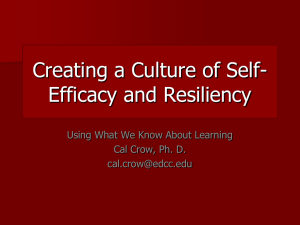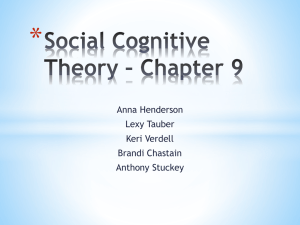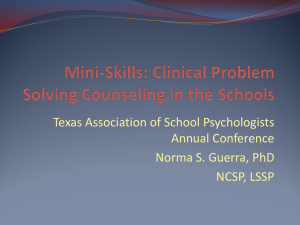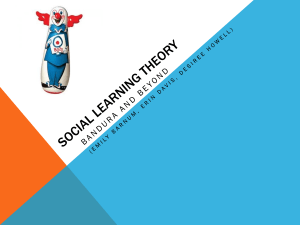Self-Efficacy and ADHD: Is there a relationship?
advertisement
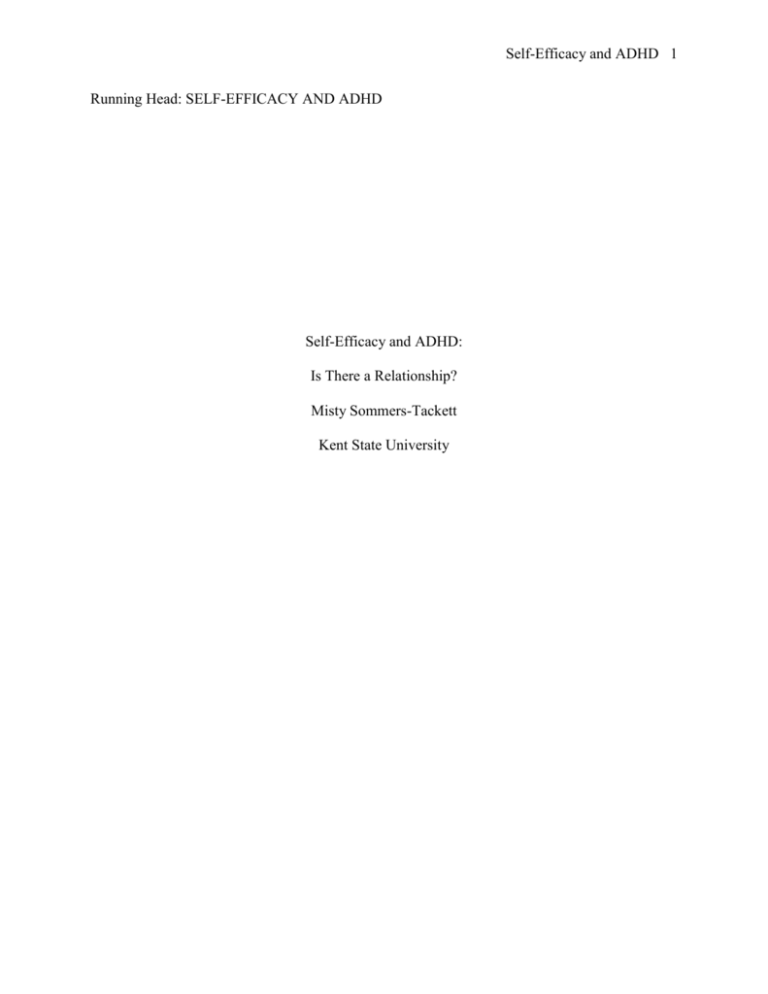
Self-Efficacy and ADHD 1 Running Head: SELF-EFFICACY AND ADHD Self-Efficacy and ADHD: Is There a Relationship? Misty Sommers-Tackett Kent State University Self-Efficacy and ADHD 2 Abstract Attention Deficit Hyperactivity Disorder is a relatively new disorder whose diagnosis has greatly increased in the last 10-15 years. It is associated with children who have problems with attention, as well as hyperactivity-impulsivity. It affects schoolwork, social relationships, as well as general daily tasks and home relationships. One area of interest is the relationship that selfefficacy has with ADHD. Self-efficacy is the belief that one has the potential to master, or successfully complete a task. This paper plans to cover research which has looked at the importance of self-efficacy in children diagnosed with ADHD as well as children without ADHD, how self-efficacy is related to the challenges of children diagnosed with ADHD and their performance, as well as the implications that self-efficacy has for school psychologists, teacher, and parents of children diagnosed with ADHD. Although self-efficacy is important in any type of disorder which interrupts social and school achievements, ADHD is the only disorder that will be discussed at this time. Self-Efficacy and ADHD 3 Self-Efficacy and ADHD: Is There a Relationship? ADHD, or Attention Deficit Hyperactivity Disorder, is a relatively new disorder among children that affects school performance, social relationships, and attentional ability. Comorbidity in ADHD is relatively high, with other problems arising such as Oppositional Defiance Disorder, Conduct Disorder, Depression, Anxiety, Mood disorders, as well as Tourette’s and other Tic disorders. To be diagnosed as having ADHD, children must consistently show one or more of these symptoms over a period of time: Inattention – difficulty focusing on any one thing, gets bored after a few minutes; Hyperactivity – high levels of activity, always in motion, can’t sit still, driven by motor; Impulsivity – difficulty curbing their reactions, don’t think before they act (Santrock 2000). Technically, the Diagnostic and Statistical Manual, Fourth Edition-TR (DSM IV-TR) requires that six or more of specific symptoms be present and persist for 6 months to a maladaptive degree, with the major two dimensions being Inattention and HyperactivityImpulsivity (DSM-IV TR 2000). Unfortunately, those diagnosed with ADHD have a difficult time staying on task, completing tasks, and paying attention. These are critical to successful completion of schoolwork. In turn, there is a greater possibility for failure, and a long record of failures is detrimental to a child’s self-efficacy. Self-efficacy is the concept of how successful you feel you will be at any particular task. The Topic of Self-Efficacy Bandura’s Theory of Self-Efficacy First let’s look at the theory of Self-efficacy. Self-efficacy is part of Bandura’s Social Cognitive Model. It is the belief that one can master a situation and produce favorable outcomes (by Albert Bandura in Santrock 2000, p.417). Self-efficacy is essential to the confidence of any child when they are trying to accomplish a task. There would be little argument to say that Self-Efficacy and ADHD 4 believing in yourself increases your chances of succeeding. It would be very difficult for a child to put forth the proper effort on any situation if they did not believe that they had the capability of succeeding at what they were trying to do. An interesting example is what happens when you let a child choose between two different tasks. Say that one task is much more difficult than the other, but has a greater reward. The task that is easy also has a reward, but is not as desirable reward. Do they choose one that is harder, or easier? The theory of self-efficacy says that if selfefficacy is great in a child, then they are more likely to choose the task with the greater reward because they believe that they have the competence/capability of being successful at the task. Studies have shown that children with high self-efficacy are more likely to succeed and be more competent in various areas of life than those with low self-efficacy. Bandura’s Social Cognitive Model says that there are three main factors that influence self-efficacy in an individual. They are behaviors, the environment, and personal/cognitive factors. Of these three, the most important in the model is the personal/cognitive factors. These are the cognitions that one has about their situations and what they believe about themselves. Bandura believed that there is more to learning than just behaviorism. What you believe about your situation is important as well. Bandura believes that people develop self-efficacy from four main sources: performance accomplishment, observation of others performance, verbal and social persuasion, and mastery experiences. Of these four, efficacy expectations are most strongly influenced by mastery experiences (Bandura, 1977 in Tollefson 2000). Mastery experiences refer to the idea that if you master one task, there is a better chance of being successful at other similar tasks. For example, if a child was able to read directions to his/her little sister, then he/she might have more confidence in reading a whole story to his/her classroom. It is important to note here that the mastery Self-Efficacy and ADHD 5 experience must be attributed to them… not luck, or chance, or others help. Self-efficacy is much higher when the success is attributed to one’s own skill, ability or effort (Holloway & Watson 2001, Tollefson 2000). Further Information on Self-Efficacy in Relation to Schools If a child’s self-efficacy is based mainly off of prior success and failure experiences, then we need to take a look at the environment where these challenges are taking place. Although there is a great deal of challenges and learning taking place in the home, a great deal of a child’s day is spent in school during the school year. Mathematically speaking, and taking into account that a child gets at least 8 hours of sleep a day, and goes to school from 8:30 am to 3:15 pm, then a child spends around 54-55% of the rest of their waking hours in school. The classroom is a very challenging environment, with numerous opportunities for a child to learn, achieve, and explore. There, they are presented with schoolwork, social challenges, physical fitness challenges, and numerous other achievement challenges. A teacher, no matter what the subject, has the opportunity to promote a child’s self-efficacy without even realizing it. At the beginning of a school year, most children begin with a clean slate. Being told, at the beginning of the year, that working hard will definitely increase their chance of success in the class is a believable statement. Unfortunately, those who do not experience success throughout the course of the year, or do not get positive feedback, might decrease their effort. They might change their self-efficacy because they believe that even though some students are able to succeed due to their hard work, they personally do not have the skills or means to succeed in class (Tollefson, 2000). Bandura believed that people develop self-efficacy from four main sources: performance accomplishment, observation of others’ performances, verbal/social persuasion, and mastery experiences (Bandura, 1977 in Tollefson, 2000). The most important of these is mastery Self-Efficacy and ADHD 6 experiences. This is the idea that if one is able to master one task, they have a higher chance of being able to master other tasks that are similar to that one (Tollefson, 2000). However, for the master experiences to enhance self-efficacy, the success of the task must be attributed to themselves, not to outside factors or to luck, fate, etc. Therefore, it is not desirable for a teacher to assign easier tasks to a student to help them feel that they succeeded, for it is not challenging to them to complete something that they have already mastered. It is also not in the best interest of the student to give them a harder task, but to give them assistance in completing the task, because they will then attribute the success to the help of the teacher and not to themselves (Tollefson, 2000). On a similar note, efficacious schools tend to have a higher expectation of their students and provide more challenging tasks to their students. Support and confidence from the teachers tends to aid in a higher overall self-efficacy in the student body. The opposite is true as well – schools that spend less time individually with students, spend less time monitoring their behavior and progress, and write off students as un-teachable tend to produce less successful student bodies (Sanford, 2003). The Importance of Instilling High Self-Efficacy Instilling a high self-efficacy in a child is very nice, and many would agree, though some might not think it is as important as others. To demonstrate the importance of high self-efficacy on children diagnosed with ADHD, it is crucial to look at the comorbid disorders that these children have. Comorbid simply means disorders that are commonly paired with another disorder. In the case of ADHD, there is comorbidity with learning disorders, anxiety, oppositional defiant disorder, conduct disorder, and major depression (DSM IV-TR 2000). Of these, major depression is a very serious issue. Major depression is associated with a higher Self-Efficacy and ADHD 7 mortality rate than most disorders (DSM IV-TR). This gives reason for the need for establishing a healthy self-efficacy in children who have ADHD. A recent study (Fischer et al., in press-b, in Mash & Barkley 2003) found a 26% risk of major depression among children diagnosed with ADHD by young adulthood. Farone and Biederman (1997, in Mash & Barkley 2003) reviewed family studies and argued that depression and ADHD share genetic predispositions. The rates of this comorbidity, however, are higher in boys than in girls (Mash & Barkley 2003). This is a scary thought when considering that boys tend to take more permanent means to suicide than girls do. Other note-worthy research is a study of 6-12 year old boys diagnosed with ADHD. This study showed that ADHD was associated with increased levels of depression, particularly in more aggressive boys, as well as decreased self-esteem (Treuting & Hinshaw 2001). When looking at the DSM IV-TR description of depression, it is important to note that one of the features of a major depressive episode is a sense of worthlessness, or ruminations over minor past failings (DSM IV-TR 2000). This alone emphasizes the importance of making sure that one instills a healthy self-efficacy within an ADHD child. An ADHD child is exposed to more minor past failures than the average child, simply due to the nature of ADHD. It is critical that these failures are handled in the appropriate way, and that the child attributes their success, not just their failures, to themselves. Self-Efficacy in relation to Children with ADHD If one looked at the concept of self-efficacy in children diagnosed with ADHD, what would they see? Using Bandura’s theory, one might think that most ADHD students would have a lower self-efficacy as a result of their difficulties with attention and completing tasks unsuccessfully in the past. Another factor which might contribute to low self-efficacy in these children might be the problems that they have in establishing healthy social relationships. Self-Efficacy and ADHD 8 Unfortunately, there are numerous areas that can contribute to a low self-efficacy in the mind of an ADHD child. So the question is, do children diagnosed with ADHD truly have a lower selfefficacy than a control sample of children? Studies have shown that children diagnosed with ADHD indeed estimate their potential success at moderately challenging tasks much lower than do control children, and those with ADHD who appear to have high self-efficacy at the beginning of a task give up on the task much quicker than do control groups (Dunn & Shapiro 1999). This paper plans to cover the results of studies which address self-efficacy in children diagnosed with ADHD, as well as the implications that self-efficacy has for school psychologists, teachers, and parents of children diagnosed with ADHD. On an interesting side note, research was done which compared the self-efficacy of LD (learning disabled) students with students that had high ability, average ability, and a combination of either with LD (Hampton & Mason 2003). This research is pertinent to the subject of children diagnosed with ADHD due to the high comorbidity of LD diagnoses with ADHD children. In fact, a child is sometimes diagnosed with a learning disability, but not ADHD, depending on the school system and how severe the ADHD might be in that particular child. In this particular study, results showed that students with LD tended to have lower selfefficacy than students without LD (Clever et al., 1992 in and Mason 2003). Also, students rated with high ability (an IQ>119) paired with LD had the lowest self-efficacy rating of all groups in the study. These particular students also perceived themselves as failures more than control students with high ability and LD students with average ability (Baum & Owen, 1988 in Hampton and Mason 2003). However, this study didn’t research the possible reasons behind these particular differences. It is the hypothesized that a higher ability or perceived ability to succeed, paired with the label of Learning Disabled has brought an increased performance Self-Efficacy and ADHD 9 pressure upon these individuals. This might be partly due to the fact that there are occasional successes in the past, which lead the student to believe that success is possible and indeed attributed to them, however, their failures have more weight than their successes and the failure is attributed to them as well due to their label of being learning disabled (Hampton and Mason 2003). Please note that there is no research listed here which might support this hypothesis. Effects of Self-Efficacy on the Emotion of Interest Self-efficacy is affected by numerous factors, emotions, and motivations. When considering the disorder of ADHD, an important quality that parents, teachers and school psychologists focus on is teaching children diagnosed with ADHD how to stay on task, and have more interest in tasks that are required for learning and achievement. A major pitfall of children who are diagnosed with ADHD is that they have difficulty keeping their attention focused on a task, especially if there is no interest in the task (DSM IV-TR 2000). An important part of attention is interest. If there is no interest, then there is little motivation for an ADHD child to attend to a task. Research done by Paul J. Silvia (2003) suggests that self-efficacy actually effects interest quadratically, or four-sided. Silvia’s interest-and-interests model assumes that only four variables influence the emotion of interest directly: conflict, complexity, novelty, and uncertainty (Silvia, in press 2001 in Silvia 2003). Self-efficacy does not affect interest directly, but relates to each of these four variables directly. In particular, the variable of uncertainty seems to play the heaviest role out of these four variables when relating self-efficacy to interest (Silvia 2003). The concept behind this is that the level of interest in a task would be increased when the possibility of success is increased. But after a critical point, a task that is estimated to be too easy would be less interesting due to the lack of challenge that it creates. To simplify, they are bored by easy tasks and frustrated by very difficult tasks (Silvia 2003). Self-Efficacy and ADHD 10 To demonstrate this, look at an example of a dart toss game. Three groups of students participating in playing a dart toss game are assigned to three different levels: easy, moderate, and difficult. The novelty of playing a game might be interesting at first, however not all of the students wanted to continue playing after the first game. The easy and difficult groups were content to end the game and stopped playing. However, the students in the moderate difficulty group were interested in playing another game (Silvia 2003). It is hypothesized that this is due to the critical level of interest in the game, in combination with the uncertainty of success, but confidence in their ability to master the task at hand (self-efficacy). Essentially, research on the relationship of interest and self-efficacy has discovered that when levels of difficulty are extremely low, and self-efficacy is extremely high, then interest is very low (Silvia 2003). Interest is also low when the opposite is true. When difficulty is high and self-efficacy is low, there is little interest. At some point when the level of difficulty and the level of self-efficacy balance out, that is when interest is at its highest (Silvia 2003). Therefore, if we are to work towards improving the attention of children diagnosed with ADHD through ways other than medication, then an important factor in their interest of a task is their self-efficacy. When the correct balance of self-efficacy and difficulty is achieved, the child’s interest will surely aid their attention span. The challenge for teachers and parents is to find that balance. Expectancy Theory in Effort Expended on a Task Another factor which is ruled by self-efficacy is the amount of effort which is put into a task. Since research has shown that an ADHD child will give up on a task faster than a child without ADHD, the amount of effort that a child puts into the task is another critical factor in the inherent success and/or completion of a task for an ADHD child. The amount of effort a child Self-Efficacy and ADHD 11 puts into a task is dependent upon two major factors according to the Expectancy x Value Theory (Feather, 1969 in Tollefson 2000). This theory states that expectancy of the task and value of the reward/outcome affects the resulting behavior. The first factor refers to the expectancy of whether or not the task being attempted will end in a successful result (Tollefson 2000). The only difference between this and self-efficacy is whether or not the successful result is attributed to themselves. Value refers to whether or not the reward, paired with the completion of the task, is of appropriate value to the child (Tollefson 2000). A large reward can be a great motivator. Reality TV shows are proof of that. Is there any reasonable motivation why someone would be willing to get stranded on an island with little food and shelter and fight to stay stranded? They would, if a million dollars was at stake. On the other hand, for some, that is not nearly enough money, because if they don’t believe that they are capable of successfully surviving, then their expectancy of winning the reward is low enough to bring down their amount of effort to get on that TV show. Summary and Discussion Summary of Information Presented To summarize, ADHD is a disorder that is characterized by unsuccessful social relationships, as well as a higher rate of failure at achievement tasks within the school setting (the home setting is not being addressed at this time). Continual past minor failures have a detrimental effect on the emotional well-being of an ADHD child, and can lead to depression in some children. Because of this, it is important to instill a healthy self-efficacy in children diagnosed with ADHD to increase their amount of interest in challenging tasks, as well as giving them confidence and a higher expectancy at success in everyday and scholastic tasks. To instill self-efficacy, it is important that the child learns to attribute their success to themselves, and not Self-Efficacy and ADHD 12 to those around them. Because of this, parents and teachers need to remember that it is important to let a child try something on their own first, before offering help. If there is too much interference, then the child might attribute the success of the task to the help that they were given. The specific issue of how self-efficacy in children with ADHD or learning disabilities compares to children without a disorder is a very interesting topic. Correlation studies have been done, but research should be narrowed down to find out the causal relationship between low selfefficacy and the diagnosis of a learning disorder. Does the label of having a disorder or having ADHD affect a child’s self-efficacy? Is it possible that having a disorder, yet still accomplishing a task might increase self-efficacy to higher levels? At this time, information is scarce on these topics. For all practical purposes, teachers and parents should keep in mind that there are studies done that show that the self-efficacy can encourage higher goal-setting, and more commitment to completing a goal, however there was no evidence that suggested that a high self-efficacy actually improved performance outcome (Vancouver, Thompson & Williams 2001). Discussion and Suggestions for Parents and Professionals The information contained here expresses the need for an appropriate balance between all the factors that influence self-efficacy. With all this information, it is important to note some strategies to help parents, teachers, and school psychologists instill higher self-efficacy in their ADHD students and children. With numerous teacher workbooks, books, websites, and games that are being designed to help children feel successful, it seems that the most important thing to keep in mind is the five major strategies for enhancing self-esteem. If these are kept in mind, then numerous possibilities can arise in daily activities for teachers and parents. Self-Efficacy and ADHD 13 To begin, the first strategy is emotional and physiological arousal (Maddux 1995). This is used mainly to calm people who become anxious at the prospect of completing a task that they feel they cannot succeed at. An example of this, is the relaxation techniques that people use when they are anxious due to a phobia, and are unable to complete a task because of their fear. This might not be as common when working with children diagnosed with ADHD, but decreasing anxiety about exams or tests by using relaxation is definitely helpful for students who are anxious because they do not have the proper self-efficacy. The second strategy is verbal persuasion (Maddux 1995). This is more obvious, as many of us need emotional support to encourage us and to remind us that we are capable of accomplishing things if our mind is set to it. Even better, is the third strategy: vicarious experiences (Maddux 1995). This is when someone experiences something through observation of others. If a child sees someone else being successful at a task, they are more likely to think that they can do it as well. Seeing someone else successfully complete a task is not nearly as effective, however, as having the child picture themselves doing it. Imagined experience is another strategy in enhancing self-efficacy (Maddux 1995). A nice exercise for a child is to describe the situation, or read a story to them about the situation, and have them close their eyes and visualize themselves doing the task. Of course, the best strategy to enhance self-efficacy is to simply perform the activity. Performance experience is the fifth strategy (Maddux 1995). The phrase “Practice makes perfect” is the perfect way to remember this. The more that one succeeds at a task in the past, the higher the expectancy for success in the future. Self-Efficacy and ADHD 14 Using these 5 strategies, as well as gauging the proper amount of help that a child needs, as they need it, will help teachers, parents, and school psychologists find ways to enhance a healthy self-efficacy in children who suffer from ADHD. The main goal should be to create the proper balance of self-efficacy using interest, rewards, and emotional support to guide the child’s attention and to keep spirits high. Supportive Information For further information on ADHD and/or how to find ways to encourage a child’s self-esteem and self-efficacy, try these online resources: http://www.modernlife.org/all_staples1999to2000/1999Months/NovemberIssue/adhd.htm - A site that discusses turning bad traits into positive thinking. Good for tips for parents/teachers. http://www.clinicaltools.com/cti/reports/adhdlivingguid/epaconference.htm - A Living Guide for ADHD http://www.allkindsofminds.com – A site created by Mel Levine which discusses all the ways that children think differently. It also has some suggestions on activities that help children monitor their successes throughout the day. http://www.sopriswest.com – A publisher who creates books that help teachers supply books of appropriate reading levels, without looking like ‘little kids’ books. Self-Efficacy and ADHD 15 References ADHD Living Guide, retrieved September 22, 2003 from http://www.clinicaltools.com/ cti/reports/adhdlivingguid/epaconference.htm ADHD: Negative traits or unrecognized talents? retrieved September 22, 2003 from http://www.modernlife.org/all_staples1999to2000/1999Months/ NovemberIssue/adhd.htm Diagnostic and Statistical Manual of Mental Disorders, 4th ed. (2000), Text Revision, American Psychiatric Association, Washington D.C., 85-93, 345-398. Dunn, P. B. and Shapiro, S. K. (1999). Gender Differences in the Achievement Goal Orientations of ADHD children, Cognitive Therapy and Research, 23(3). 327-344. Hampton, N. Z.; Mason, E.(2003). Learning Disabilities, Gender, Sources of Efficacy, SelfEfficacy Beliefs, and Academic Achievement in High School Students, Journal of School Psychology 41(2). 101-112. Holloway, A., and Watson, H. E. (2002). International Journal of Nursing Practice, 8. 106-115. Levine, M. (2002). A Mind At A Time. New York: Simon & Schuster. Maddux, J. E. (Ed). (1995). Self-Efficacy, Adaptation, and Adjustment; Theory, Research, and Application. New York: Plenum. Mash, E. J. and Barkley, R. A. (2003). Childhood Mood Disorders. In Mash, E. J. and Barkley, R. A., Child Psychopathology, Second Edition (pp.233-278). New York:The Guilford Press. Mash, E. J. and Barkley, R. A., (2003) Attention-Deficit/Hyperactivity Disorder, In Mash, E. J. and Barkley, R. A. Child Psychopathology, Second Edition (pp.75-143). New York:The Guilford Press. Self-Efficacy and ADHD 16 Santrock, J.W. (2003). Children, 7th Edition. New York, NY: McGraw Hill. Silvia, P. J. (2003). Self-Efficacy and interest: Experimental Studies of optimal incompetence, Journal of Vocational Behavior, 62. 237-249. Tollefson, N. (2000). Classroom Applications of Cognitive Theories of Motivation, Educational Psychology Review, 12(1.) 63-83. Treuting, J. J., and Hinshaw, S. P. (2001). Depression and Self-Esteem in Boys with AttentionDeficit/Hyperactivity Disorder: Associations with Comorbid Aggression and Explanatory Attributional Mechanisms. Journal of Abnormal Child Psychology, 29(1). 23-39. Vancouver, J. B., Thompson, C. M., and Williams, A. A. (2001). Journal of Applied Psychology, 86(4). 605-620.

